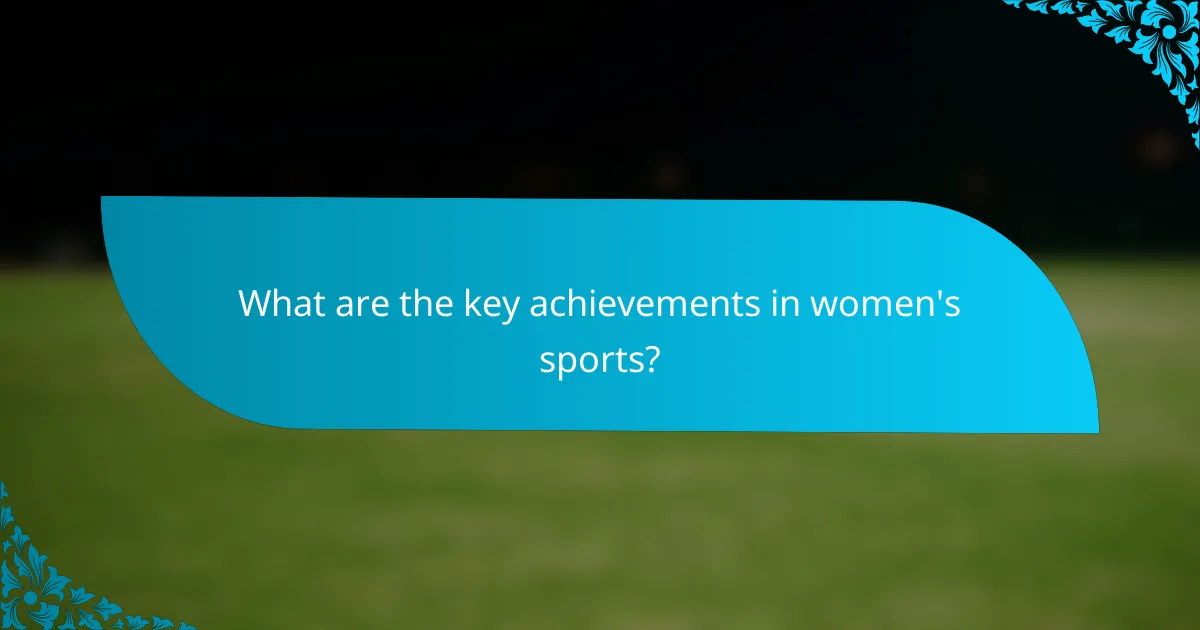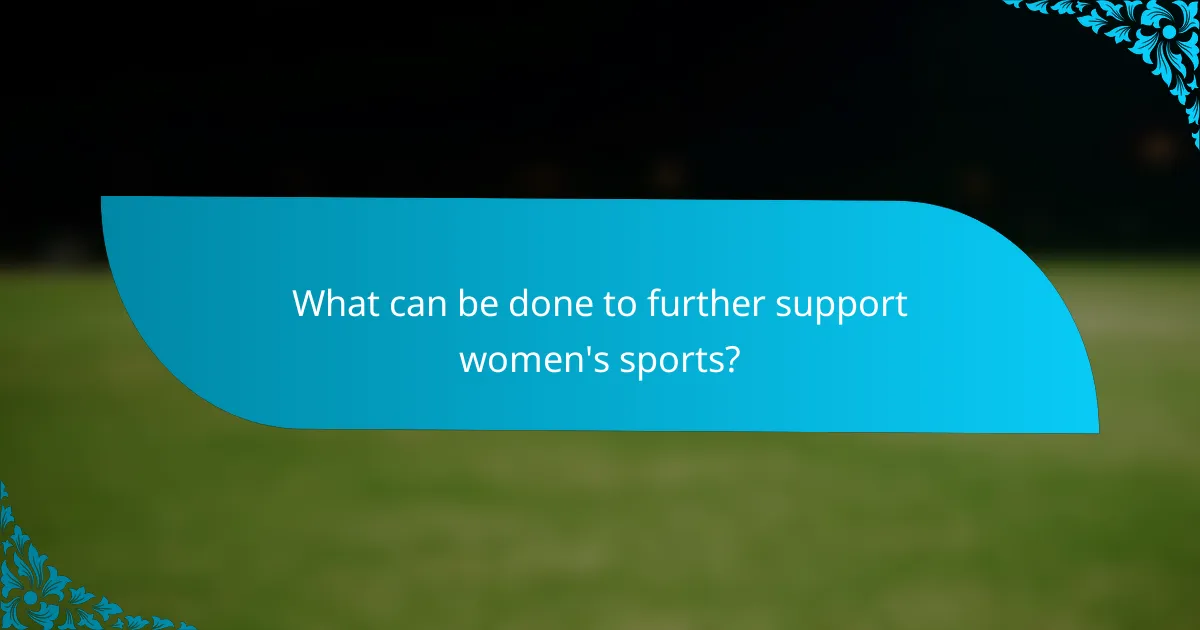Women’s sports have seen significant achievements, including the establishment of professional leagues like the Women’s National Basketball Association (WNBA) and the success of the United States Women’s National Team in soccer, winning the FIFA Women’s World Cup four times. The introduction of women’s events in the Olympics began in 1900, and legislation such as Title IX has greatly increased female participation in sports. The article will explore the current landscape of women’s sports, highlighting the rise in media coverage, sponsorship, and participation rates, as well as the ongoing advocacy for equal pay. It will also discuss strategies for further growth, including increased funding, scholarships, and support for women’s sports programs.

What are the key achievements in women’s sports?
Key achievements in women’s sports include the establishment of professional leagues and increased visibility. The Women’s National Basketball Association (WNBA) was founded in 1996, providing a platform for female basketball players. In soccer, the United States Women’s National Team won the FIFA Women’s World Cup four times, in 1991, 1999, 2015, and 2019. The introduction of women’s events in the Olympics began in 1900, with tennis and golf. Title IX legislation in 1972 significantly increased female participation in school sports in the United States. In 2019, the U.S. women’s soccer team won the ESPY Award for Best Team. Female athletes have broken records, such as Katie Ledecky in swimming and Serena Williams in tennis. The growth of women’s sports has also led to increased sponsorship and media coverage, reflecting societal changes.
How have women athletes impacted their respective sports?
Women athletes have significantly transformed their respective sports. They have increased visibility and participation in athletics. This has led to greater investment and sponsorship opportunities. For example, the Women’s National Basketball Association (WNBA) has grown in popularity since its inception in 1996. According to a 2021 report, the WNBA’s viewership increased by 51% compared to the previous season. Women athletes have also advocated for equal pay and better conditions. The U.S. Women’s National Soccer Team’s fight for equal pay garnered widespread attention. Their legal battle resulted in a landmark agreement in 2022, ensuring equal compensation. Additionally, women athletes have shattered records and set new standards in performance. For instance, Serena Williams has won 23 Grand Slam singles titles, the most in the Open Era. Overall, women athletes have paved the way for future generations and inspired societal change in sports.
What records have been broken by women in sports?
Women in sports have broken numerous records across various disciplines. For example, Katie Ledecky holds the world record in the women’s 800-meter freestyle with a time of 8:04.79. In athletics, Florence Griffith-Joyner set the women’s 100-meter world record at 10.49 seconds in 1988.
Additionally, the U.S. women’s national soccer team won the FIFA Women’s World Cup four times, showcasing their dominance. In tennis, Serena Williams achieved the most Grand Slam singles titles in the Open Era with 23 titles.
Moreover, in gymnastics, Simone Biles has set records for the most World Championship medals, totaling 25. These achievements highlight the remarkable contributions of women in sports.
Which women athletes are considered pioneers in their fields?
Women athletes considered pioneers in their fields include Billie Jean King, who fought for gender equality in tennis. She won 39 Grand Slam titles and famously defeated Bobby Riggs in the “Battle of the Sexes” in 1973. Another pioneer is Wilma Rudolph, the first American woman to win three gold medals in a single Olympics in 1960. She overcame polio to achieve her success. Additionally, Mia Hamm is recognized for her contributions to women’s soccer. She played a key role in popularizing the sport in the United States and won two FIFA Women’s World Cups. These athletes broke barriers and inspired future generations in their respective sports.
What challenges do women face in sports today?
Women face significant challenges in sports today, including gender inequality and limited access to resources. Disparities in funding persist, with women’s sports receiving only a fraction of the investment compared to men’s. A study by the Women’s Sports Foundation shows that female athletes often lack adequate facilities and training opportunities. Media coverage of women’s sports remains minimal, impacting visibility and sponsorship potential. Additionally, societal stereotypes continue to undermine women’s participation in competitive sports. These challenges contribute to a lack of representation in leadership roles within sports organizations. The ongoing fight for equal pay highlights the economic disparities faced by female athletes. Overall, these factors create barriers that hinder the growth and recognition of women’s sports.
How does gender inequality manifest in sports environments?
Gender inequality in sports environments manifests through disparities in funding, media coverage, and opportunities. Women athletes often receive significantly less financial support compared to their male counterparts. For instance, a 2021 report by the Women’s Sports Foundation highlighted that female athletes receive only 4% of sports media coverage. This lack of visibility affects sponsorship opportunities and public interest. Additionally, women have fewer opportunities to participate in high-level competitions. According to the NCAA, women’s sports receive only 28% of overall athletic budgets in colleges. This creates an environment where female athletes struggle for recognition and resources. Gender stereotypes further perpetuate inequality, influencing perceptions of women’s capabilities in sports. These factors collectively hinder the growth and development of women’s sports.
What barriers exist for women in professional sports?
Barriers for women in professional sports include unequal pay, limited media coverage, and lack of sponsorship opportunities. Women athletes often receive significantly lower salaries compared to their male counterparts. For example, the U.S. Women’s National Soccer Team filed a lawsuit for equal pay, highlighting wage disparities. Media coverage of women’s sports is disproportionately low, with only 4% of sports media coverage dedicated to women’s events. This lack of visibility affects the growth of female sports. Additionally, sponsorship deals for women athletes are often less lucrative, limiting their financial support. These barriers collectively hinder the advancement of women in professional sports.

How is the future of women’s sports evolving?
The future of women’s sports is evolving towards greater visibility and support. Increased media coverage is showcasing women’s achievements. Sponsorship deals for women’s teams are on the rise. Participation rates among young girls in sports are increasing significantly. For instance, girls’ participation in high school sports has grown by 1,000% since the passage of Title IX in 1972. Social media platforms amplify female athletes’ voices and stories. Advocacy for equal pay is gaining momentum, with some leagues making significant strides. Overall, these factors contribute to a more equitable landscape for women’s sports.
What trends are shaping the growth of women’s sports?
Increased investment in women’s sports is a key trend shaping its growth. Major sponsors are allocating larger budgets to women’s teams and events. This financial support enhances visibility and resources for female athletes. Media coverage of women’s sports has also expanded significantly. Research indicates that viewership for women’s sporting events has risen, attracting a broader audience. Social media platforms are amplifying women’s sports narratives, increasing fan engagement. Grassroots initiatives are fostering talent development from a young age. Finally, advocacy for gender equality in sports is gaining momentum, influencing policy changes and funding allocations.
How are media representations of women in sports changing?
Media representations of women in sports are becoming more positive and diverse. Historically, coverage focused on women’s appearance rather than athletic performance. Recent shifts highlight female athletes’ achievements and skills. For instance, the 2021 Tokyo Olympics showcased women in various sports, increasing visibility. Studies indicate that female athletes receive more media attention than in previous decades. In 2020, women’s sports coverage reached 10% of sports media, up from 4% in 2014. Social media platforms amplify women athletes’ voices and stories. This change reflects a broader societal push for gender equality in sports.
What role do sponsorships play in the advancement of women’s sports?
Sponsorships significantly contribute to the advancement of women’s sports. They provide essential funding, which helps in the development of athletes and teams. Increased financial support leads to improved training facilities and resources. Sponsorships also enhance visibility through marketing and promotional activities. This visibility attracts more fans and increases attendance at events. Brands that sponsor women’s sports help to challenge gender stereotypes in athletics. For instance, the investment in women’s soccer has led to a rise in participation rates. According to a report by the Women’s Sports Foundation, sponsorships have grown by 50% in recent years, indicating a positive trend.
How is youth participation influencing the future of women’s sports?
Youth participation is significantly influencing the future of women’s sports. Increased involvement of young girls in sports is leading to greater visibility and support for women’s athletics. Participation at a young age fosters talent development and encourages lifelong engagement in sports. According to a report by the Women’s Sports Foundation, girls who play sports are more likely to continue in athletics as adults. This trend boosts representation in professional leagues and enhances sponsorship opportunities. Moreover, youth sports programs are increasingly prioritizing gender equity, promoting equal access and resources. As more girls participate, the demand for women’s sports coverage and funding rises. This shift is reshaping perceptions and creating a more inclusive sports culture.
What programs are encouraging young girls to engage in sports?
Programs encouraging young girls to engage in sports include Girls on the Run and the Women’s Sports Foundation’s initiatives. Girls on the Run focuses on building confidence and physical fitness through running. The program serves over 200,000 girls annually across the United States. The Women’s Sports Foundation promotes sports participation through grants and educational resources. Their initiatives support girls in underserved communities. Additionally, local community sports leagues often have programs specifically designed for young girls. These programs aim to foster teamwork and leadership skills. Research shows that participation in sports can improve self-esteem and academic performance in girls.
How do grassroots movements contribute to women’s sports development?
Grassroots movements significantly contribute to women’s sports development by fostering participation and creating opportunities. These movements engage local communities, encouraging girls to participate in various sports. They often provide resources such as coaching, facilities, and funding. For example, programs like Girls on the Run have successfully promoted physical activity among girls across the United States. Additionally, grassroots initiatives advocate for policy changes that support women’s sports. They raise awareness about gender disparities, pushing for equal funding and media coverage. Studies show that increased visibility leads to higher participation rates. Overall, grassroots movements play a crucial role in empowering women in sports and driving systemic change.

What can be done to further support women’s sports?
Increase funding for women’s sports programs. This can enhance training facilities and resources. Provide scholarships specifically for female athletes. This encourages participation at all levels. Promote women’s sports through media coverage. Increased visibility can attract more fans and sponsors. Support initiatives that advocate for equal pay. This addresses wage disparities in professional sports. Encourage schools to offer more women’s sports teams. This fosters early interest and development in female athletes. Collaborate with organizations that focus on gender equity in sports. Their expertise can guide effective strategies for growth.
What initiatives are currently in place to promote women’s sports?
Various initiatives are currently in place to promote women’s sports. Organizations like the Women’s Sports Foundation advocate for gender equity in sports. They provide funding and resources to support female athletes. The NCAA has implemented programs to increase visibility for women’s sports. Their initiatives include scholarships and enhanced media coverage. Additionally, the International Olympic Committee has increased investment in women’s events. They aim to achieve gender parity in participation by 2024. Local community programs also encourage girls to participate in sports through clinics and leagues. These initiatives collectively aim to elevate women’s sports and inspire the next generation of female athletes.
How can communities better support female athletes?
Communities can better support female athletes by providing equal access to resources and facilities. This includes funding for women’s sports programs and scholarships. Equal media coverage is crucial to raise awareness and recognition. Mentorship programs can connect young female athletes with role models. Organizing community events can promote female participation in sports. Providing training and development opportunities is essential for skill enhancement. Collaborating with schools to encourage girls’ sports participation can foster early interest. Engaging local businesses for sponsorship can also increase support. Research indicates that community involvement significantly boosts female athlete participation and success.
What are practical tips for supporting women’s sports?
Support women’s sports by attending games and events. This boosts attendance and visibility. Purchase merchandise from women’s teams to provide financial support. Engage on social media by sharing and promoting women’s sports content. Advocate for equal funding and resources in schools and organizations. Encourage local businesses to sponsor women’s teams. Volunteer time or skills to help with events or training. Promote female athletes in media and conversations. Research shows increased visibility leads to greater participation and support for women’s sports.
How can fans engage with women’s sports at local and national levels?
Fans can engage with women’s sports at local and national levels by attending games and events. Local events offer fans the chance to support teams directly. National events showcase top athletes and competitions. Fans can also participate in community programs promoting women’s sports. Volunteering for local teams fosters a deeper connection. Social media provides platforms for fans to share experiences and promote events. Supporting merchandise helps financially sustain women’s sports. Engaging in conversations about women’s sports raises awareness and encourages others to participate. These actions collectively strengthen the visibility and support for women’s sports.
What actions can individuals take to advocate for gender equality in sports?
Individuals can advocate for gender equality in sports by supporting female athletes and organizations. They can attend women’s sporting events to show support and raise awareness. Promoting female athletes on social media helps increase visibility. Individuals can also volunteer with organizations that focus on women’s sports. Donating to programs that empower young female athletes is impactful. Engaging in conversations about gender equality in sports can influence others. Signing petitions that promote equal pay in sports raises awareness of disparities. Lastly, advocating for media coverage of women’s sports helps change perceptions and encourages equity.
The main entity of this article is women’s sports, highlighting key achievements, challenges, and future growth. It covers significant milestones such as the establishment of professional leagues, record-breaking performances, and the impact of legislation like Title IX on female participation. The article discusses the ongoing challenges women face, including gender inequality, limited media coverage, and sponsorship disparities. Additionally, it explores grassroots movements and initiatives aimed at promoting women’s sports, as well as the evolving landscape of youth participation and media representation. Ultimately, the article emphasizes the importance of support and advocacy for the advancement of women in sports.
